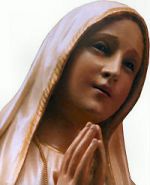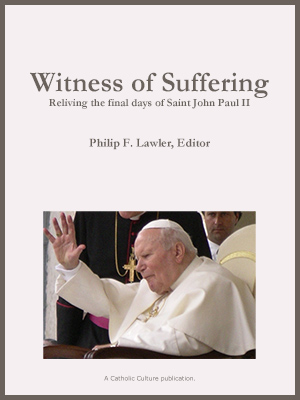Catholic World News News Feature
Follow Up October 18, 2001
In October 1999 Bishop David Foley of Birmingham, Alabama, issued new norms for the celebration of Mass in his diocese. The most remarkable feature of the bishop's directive--and the one that caused the sharpest cries of protest--was his insistence that priests in Birmingham could not celebrate Mass facing ad orientem--that is, facing with the congregation toward the East.
Bishop Foley explained that he was issuing new canonical legislation regarding the celebration of Mass in his diocese, in fulfillment of his "absolute duty to protect [the liturgy] from innovation and sacrilege." There is no question that a diocesan bishop has the duty to protect against liturgical abuses, and the authority to issue decrees to that end. But the form of Bishop Foley's decree, and in particular prohibition of the ad orientem pasture, raised questions in some quarters (including this magazine's editorial page). In an era of widespread liturgical abuse, is it really plausible to suggest that the faithful would be shocked when a priest faces toward the tabernacle--following a time-honored Catholic tradition? And does a bishop have the authority to forbid a practice which is approved by the liturgical laws of the universal Church?
THE EWTN FACTOR
The bishop's directives applied to all Catholic priests celebrating Mass in the Birmingham diocese. But the real purpose of his decree was clear from the fact that he set down explicit guidelines to be observed whenever the Mass is televised. Most priests--in Birmingham as elsewhere--do not ordinarily make provisions for the television broadcast of Sunday Mass. But the Birmingham diocese is the home of the Eternal Word Television Network (EWTN), which broadcasts Mass every day to an audience of hundreds of thousands of faithful Catholics in America and around the world.
Up until the time when Bishop Foley issued his directives, the daily Mass on EWTN was celebrated with the priest facing ad orientem. It was no secret that some liturgists found fault with the EWTN broadcast, claiming that it promoted an "old-fashioned" approach to the liturgy. And precisely at the time when the bishop issued his guidelines, EWTN was completing the construction of a new chapel. The placement of the altar in that chapel would be dictated in part by the plans for the broadcast of the daily Mass. Would it be set up to accommodate a priest in the ad orientem celebration? The bishop's directives were clearly written with the EWTN situation in mind.
Relations between Bishop Foley and EWTN's founder, Mother Angelica, had always been cordial. The bishop was a regular guest on EWTN shows, and sat on the network's board of directors. Father Richard Donahue, the secretary for liturgy in the Birmingham diocese, told Catholic News Service that the norms for televising the Mass were not intended as a disciplinary restraint on the work of Mother Angelica. As he put it the norms "are not going after her, but they are intended to make her work even better."
However, Mother Angelica (and her viewers) clearly preferred the ad orientem posture. So the bishop's decree had the effect of forcing EWTN either to abandon its plans (to continue broadcasting Mass celebrated in the ad orientem posture) or to mount a direct challenge to the bishop's canonical authority. EWTN acceded to the bishop's wishes.
On February 22, 2000, Bishop Foley issued a new document: "Norms for Televising the Mass in the Diocese of Birmingham in Alabama." And when EWTN implemented those norms, the bishop wrote to his priests, saying, "Now I see no reasons for the General Decree of October 18, 1999." In a formal document on the same date, he withdrew the canonical decree "in its entirety."
This left the Birmingham diocese in an odd situation. The canonical decree, which had juridical force, was null and void. The norms for televising the Mass, which have no canonical force, remained in place. Technically, a priest was free to celebrate Mass ad orientem in the Birmingham diocese, unless that Mass was televised.
Bishop Foley said that his norms for the televised Mass had received approval from the Vatican. Therein lies another tale.
VATICAN APPROVAL: FOR WHAT?
As he unveiled his new norms for the televised Mass, Bishop Foley also revealed that he had asked the Vatican for guidance on the question of the ad orientem posture, and received approval for his position. But a second look at the bishop's announcement suggests that the story might not be quite so simple.
A story circulated by Catholic News Service (the US bishops' news agency), which appeared in dozens of diocesans newspapers around the United States, reported that Bishop Foley had asked the Vatican for guidance after an unnamed priest delivered a speech to an audience in Birmingham, in which (according to the CNS story) the priest argued that the ad orientem posture was "the only true perennial tradition of the Church." Bishop Foley, the story continued, wrote to the Vatican's Congregation for Divine Worship, asking for an "authoritative clarification on these most contentious matters."
The prefect of that Vatican congregation, Cardinal Jorge Medina Estevez, responded to Bishop Foley's request by saying that the views of this unnamed priest, as they had been recounted in the bishop's query, were wrong.
Regarding the ad orientem celebration, Cardinal Medina observed that the Roman Missal assumes that the priest is facing the people, "leaving open the possibility of his celebrating toward the apse." His letter continued:
These two options carry with them no theological or disciplinary stigma of any kind. It is therefore incorrect and indeed quite unacceptable that anyone affirm, as your excellency sums up this view, that to celebrate towards the apse "is a theologically preferable or more orthodox choice for a priest who wishes to be true to the Church's authentic tradition."
The cardinal's letter makes it quite clear that a priest may celebrate Mass facing the people. But that fact was never in question. The letter from Cardinal Medina does not lend any Vatican support to Bishop Foley's justification for a ban on the ad orientem celebration. On the contrary, the text of the cardinal's letter--acknowledging the ad orientem posture as one of "two options," neither of which bears any "theological or disciplinary stigma of any kind"--would seem to support the argument that priests should be free to celebrate the Mass ad orientem.
The theological view condemned by Cardinal Medina's letter--the view that only the ad orientem celebration of the Mass should be licit--is not frequently heard among American Catholics. So a question naturally arose: Who was this contentious priest whose lecture to a Birmingham audience had prompted Bishop Foley to seek an "authoritative clarification" from the Vatican. Eventually an answer emerged; a spokesman for the Birmingham diocese revealed that the bishop was thinking of Father Joseph Fessio, SJ--the publisher of Catholic World Report.
Father Fessio did indeed deliver an address to an audience in Birmingham in May 1999, and he did indeed speak on the question of the ad orientem posture. But he did not suggest that this was the only valid posture for the celebration of the Eucharistic Sacrifice. After explaining why he preferred not to celebrate Mass facing the people, Father Fessio clarified his attitude toward that form of celebration:
Now is it a sin? No. Is it wrong? No. Is it permitted? Yes. Is it required? Not at all.
The CWR publisher went on to suggest not that priests should be barred from saying Mass facing the people, but rather that they should be allowed to celebrate Mass ad orientem:
There is no required permission to say Mass facing God, facing the tabernacle, facing East, facing with the people; and it should be given equal rights, it seems to me, with Mass facing the people.
Bishop Foley's original decree raised the question of whether a bishop can ban a practice that is approved by the universal Church. Now another question has been added: Can a liturgical practice (such as the ad orientem celebration) be deemed licit under ordinary circumstances, but illicit when the Mass is televised? These questions remain unresolved, and this story is not complete.






